A Brief Colonial History Of Ceylon(SriLanka)
Sri Lanka: One Island Two Nations
A Brief Colonial History Of Ceylon(SriLanka)
Sri Lanka: One Island Two Nations
(Full Story)
Search This Blog
Back to 500BC.
==========================
Thiranjala Weerasinghe sj.- One Island Two Nations
?????????????????????????????????????????????????Saturday, June 12, 2021
How Israel is turning Sheikh Jarrah into another Hebron
Israeli police have transformed Sheikh Jarrah into a hyper-militarized area designed to quash Palestinian resistance and embolden Jewish settlers.
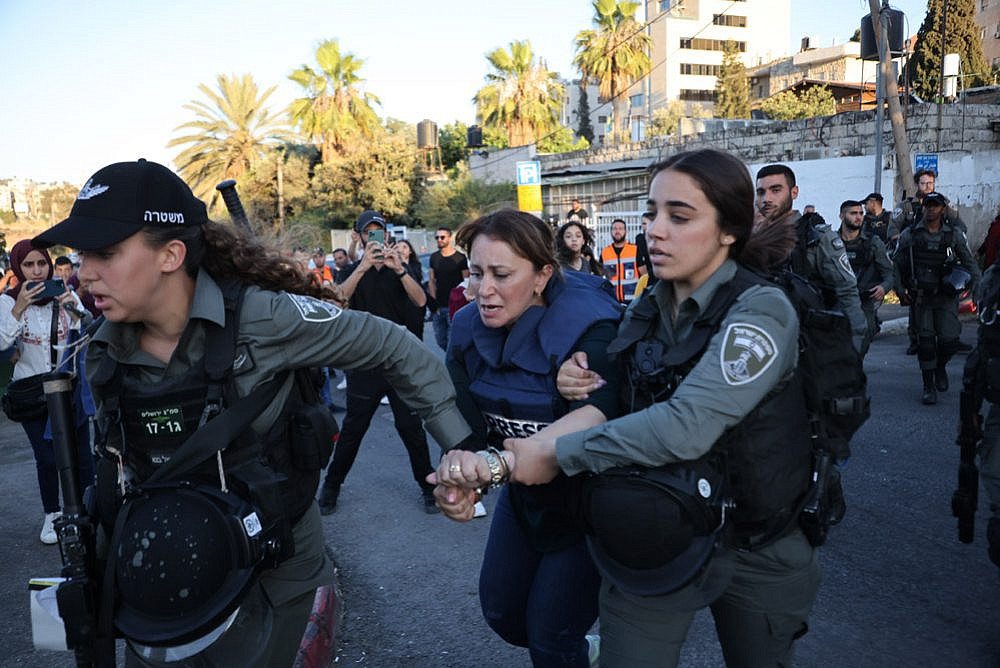 |
Israeli officers arrest Al Jazeera reporter Givara Budeiri in the East Jerusalem neighborhood of Sheikh Jarrah, June 6, 2021. (Oren Ziv)
In recent weeks, Othman Ibn Affan, the main thoroughfare in the East Jerusalem neighborhood of Sheikh Jarrah, has begun to resemble Hebron’s infamous segregated Shuhada Street. Israeli police forces have established militarized checkpoints, are patrolling the area 24/7, forbidding the entry of Palestinians who do not live in the neighborhood, and allowing complete freedom of movement for settlers and right-wing activists.
These policies were initially put in place to prevent Palestinians from joining and expressing solidarity with four families under imminent threat of forced expulsion. But like in Shuhada Street — where non-resident Palestinians are banned, and local Palestinians live under the constant threat of violence by settlers and soldiers alike — the police’s goal in Sheikh Jarrah is to choke Palestinian presence in the neighborhood and to quash any form of resistance, from demonstrations to street art.
The curtailing of movement in and out of Othman Ibn Affan began last month after Israeli police set up a makeshift checkpoint at the entrances to the street, following a deal struck between the police and Kahanist MK Itamar Ben Gvir. Ben Gvir, who was pressured to remove a makeshift “office” he had set up on the street to show his support for the settlers there, agreed to do so on the condition that the police patrol the neighborhood at all hours of the day and night.
Israel Police Chief Ya’akov Shabtai said that Ben Gvir’s provocations, along with a march led by far-right youth in Jerusalem in late April, was a central reason for the eruption of violence in the city — and then across Israel-Palestine — later in May.
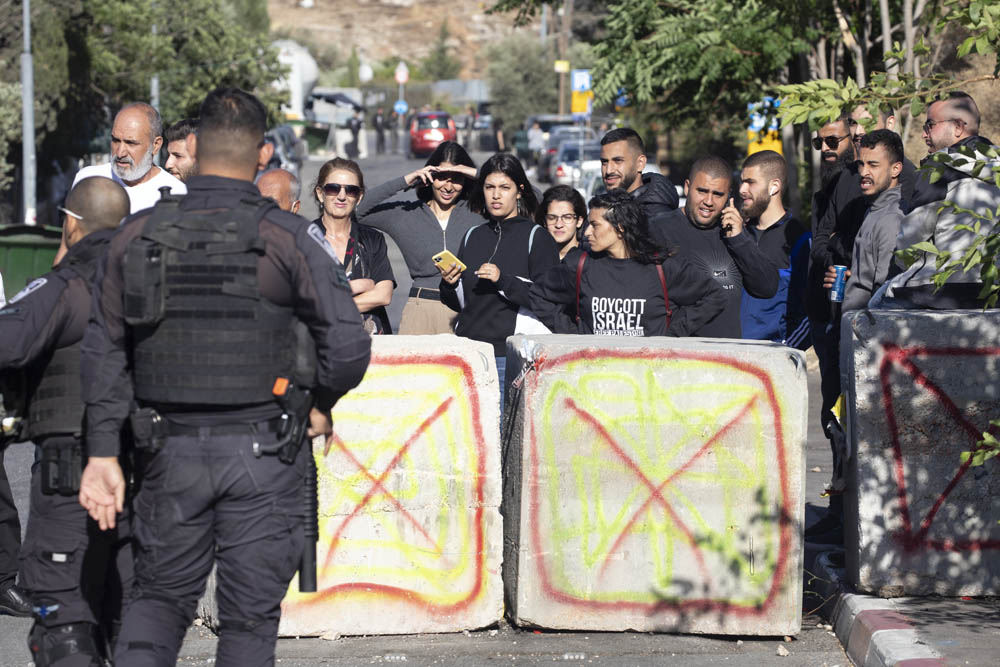 |
Police set up concrete road blocks at the entrance to the East Jerusalem neighborhood of Sheikh Jarrah. While settlers and right-wing Jews are allowed to walk in freely, non-resident Palestinians are barred from entry. (Oren Ziv)
What began as a single checkpoint in Sheikh Jarrah, however, turned into a permanent police presence on May 16, after a Palestinian rammed his vehicle into officers standing at the checkpoint, wounding seven; the police shot dead the assailant. The police then set up concrete road blocks at the same spot.
The limitations on movement have had a severe effect on the life of Sheikh Jarrah’s residents in recent weeks. Palestinians who live on the street are constantly asked for their IDs, while their relatives who live outside the neighborhood are not allowed to enter, even on Muslim holidays. Entrance is completely forbidden for activists — whether Palestinian or left-wing Israeli Jews — and those who manage to sneak in are removed by police.
“The street has become Shuhada number two,” said Salah Diab, a Palestinian resident under threat of being expelled from his home and one of the leaders of the struggle in Sheikh Jarrah. Last month, police broke Diab’s leg during a raid on his home; days later he was arrested after settlers attacked Palestinians who held their iftar meal — the nightly feast that breaks the Ramadan fast — on the sidewalk outside his house.
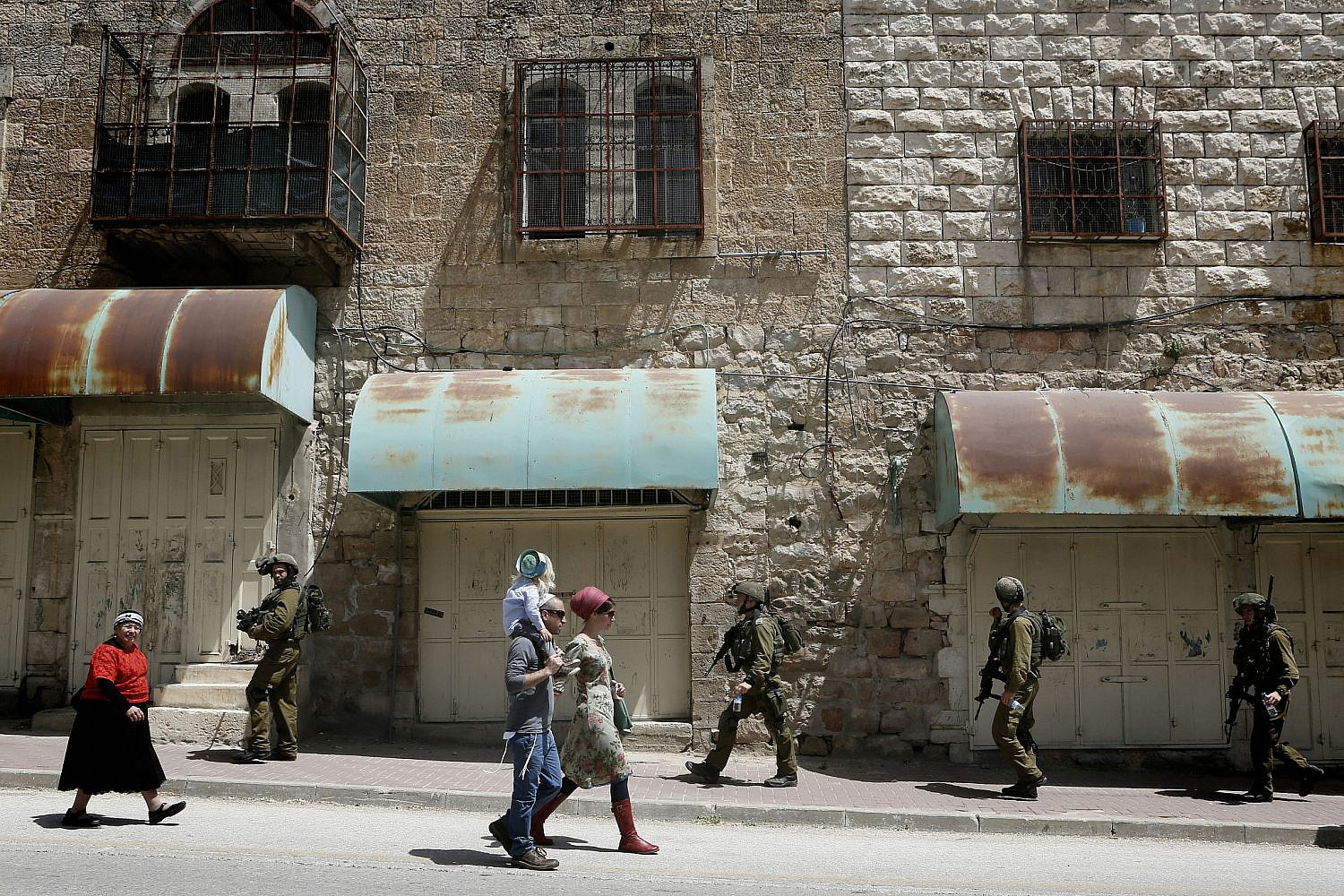 |
Israeli soldiers patrolling on Shuhada Street in the West bank city of Hebron, as hundreds of Orthodox Jews arrive to pray at the Cave of the Patriarch, during the Jewish holiday of Passover. April 16, 2014. (Miriam Alster/Flash90)
“The police are stupid, they try to do everything by force,” Diab said. “They work for the settlers who give them orders. This is not a surprise for us, but we won’t allow it to happen. Day after day, we will continue to struggle for justice.”
‘They only want to scare us’
The “Hebronization” of Sheikh Jarrah is further apparent in the intensive police activity over recent weeks. Officers have dispersed dozens of Palestinians — most of them young people who came to sing, eat, and hang out in the neighborhood — with stun grenades, water cannons, and mass arrests. They also regularly raid the homes in the neighborhood, looking for people who don’t live in the area yet have managed to enter.
The police have frequently ramped up their acts of violence. On May 15, during the one-day nation-wide Palestinian general strike, a police officer was filmed shooting 16-year-old Jana Kiswani, who was standing at the entrance of her house, with a sponge-tipped bullet. She sustained an injury to her spine and will need to spend months in bed. The officer who shot Kiswani was later suspended.
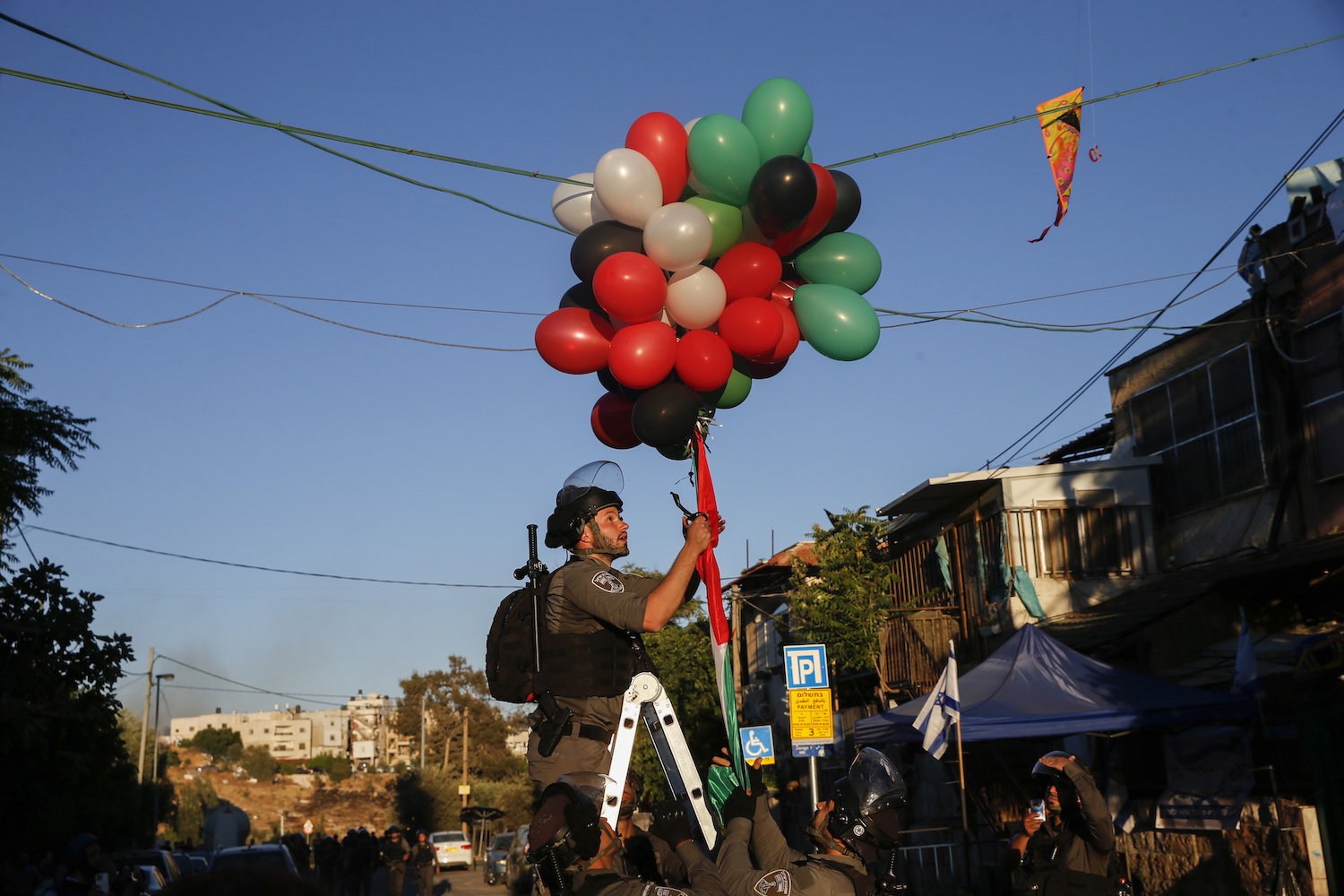 |
An Israeli police officer tries to take down balloons released by Palestinians in the East Jerusalem neighborhood of Sheikh Jarrah on May 15, 2021. (Jamal Awad/Flash90)
“Closing the street is part of the attempt to pressure the residents,” said Zakaria Odeh, the coordinator for the Civic Coalition for Palestinian Rights in Jerusalem. “Together with the skunk water cannon, the house raids, and arrests of youth — it’s part of the policy to target a neighborhood that is in the heart of Jerusalem, in order to control the whole area.”
These repressive policies in Sheikh Jarrah reached new heights on Sunday when the police arrested siblings Muna and Mohammed El-Kurd, the two most prominent activists in the neighborhood, claiming they were “taking part in disturbances.” Police officers raided the family house to arrest Muna and put out a warrant for Mohammed, who was outside the neighborhood at the time and was taken to the police station upon his return. Zoheir Rajabi, a leader of the struggle in the Batan al-Hawa neighborhood of Silwan, was also arrested.
At a press conference held outside the police station on Salah a-Din Street in East Jerusalem, Nabil El-Kurd, Muna and Mohammed’s father, said: “This is a digital war. We have cameras on our phones and our words to promote the Palestinian cause.”
Just hours after the arrest, the police tried to move Muna to a police vehicle from the station’s side door, all while throwing dozens of stun grenades at activists and journalists who were outside the station. Muna was then driven to the Russian Compound, an infamous interrogation center and police station in West Jerusalem, where she was released without conditions — a rare decision when it comes to political arrests.
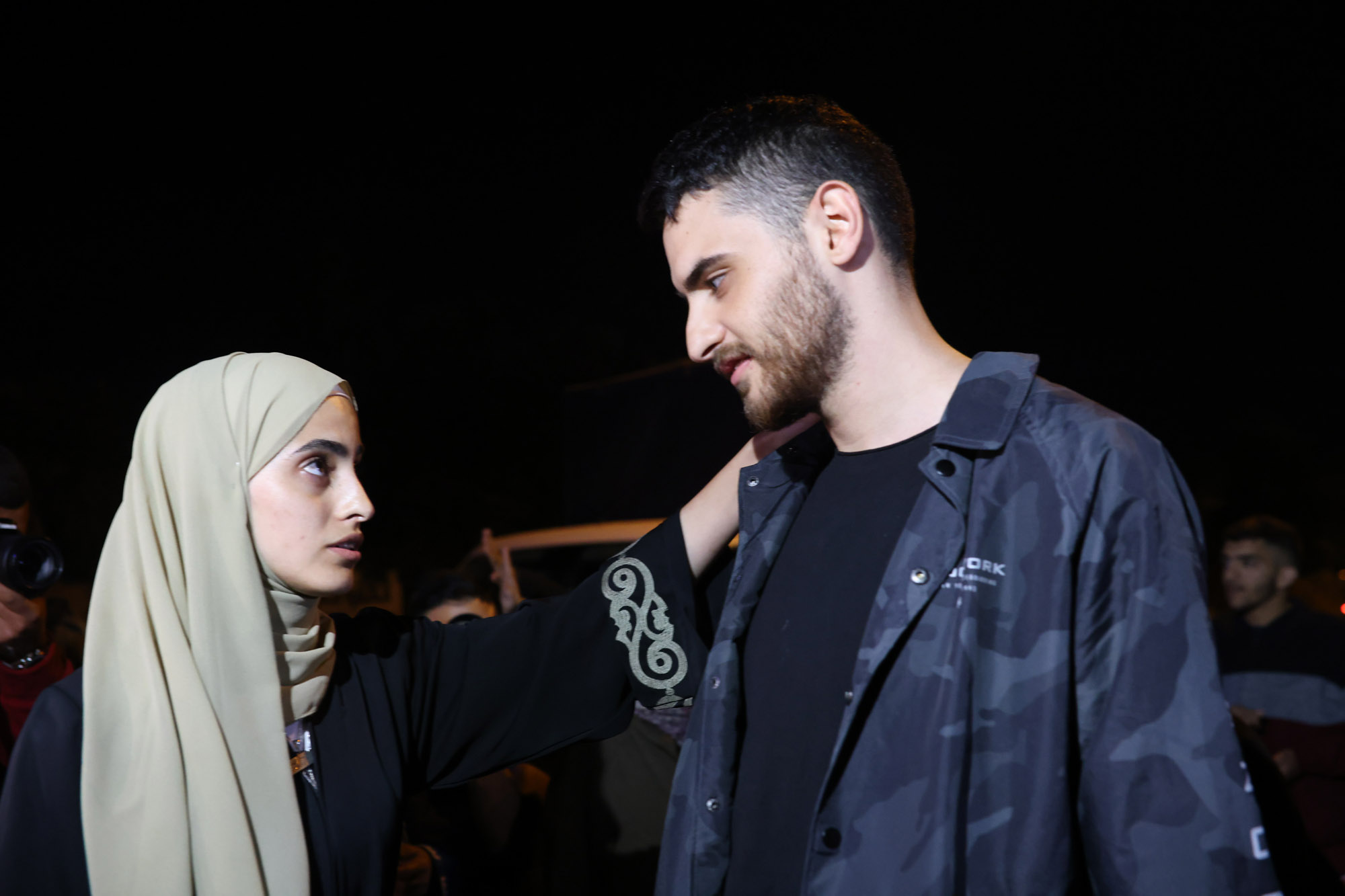 |
Muna El-Kurd (left) and her brother Mohammed seen after being released from police custody, June 7, 2021. (Oren Ziv)
“They only want to scare us,” Muna told journalists after returning home on Monday afternoon. “I was interrogated twice, had my legs and my hands cuffed… These are the actions of the occupation, to scare and intimidate [us]. It is why they closed our street while we were speaking out and showing the world what is happening here. We are the fourth generation in Sheikh Jarrah and they want us out — but they won’t succeed.”
Mohammed was also released later that night without conditions. “This is a clear intimidation move to stop us from speaking out against the injustices that [the settlers] commit,” he said following his release. “They said we were inciting violence, when clearly the only incitement is the presence of an illegal blockade in Sheikh Jarrah and the presence of settler outposts who are threatening to burn and kick us out of our homes.”
Criminalizing balloons, kites, and street art
In addition to local residents and activists, the Hebronization of Sheikh Jarrah is also being extended to journalists.
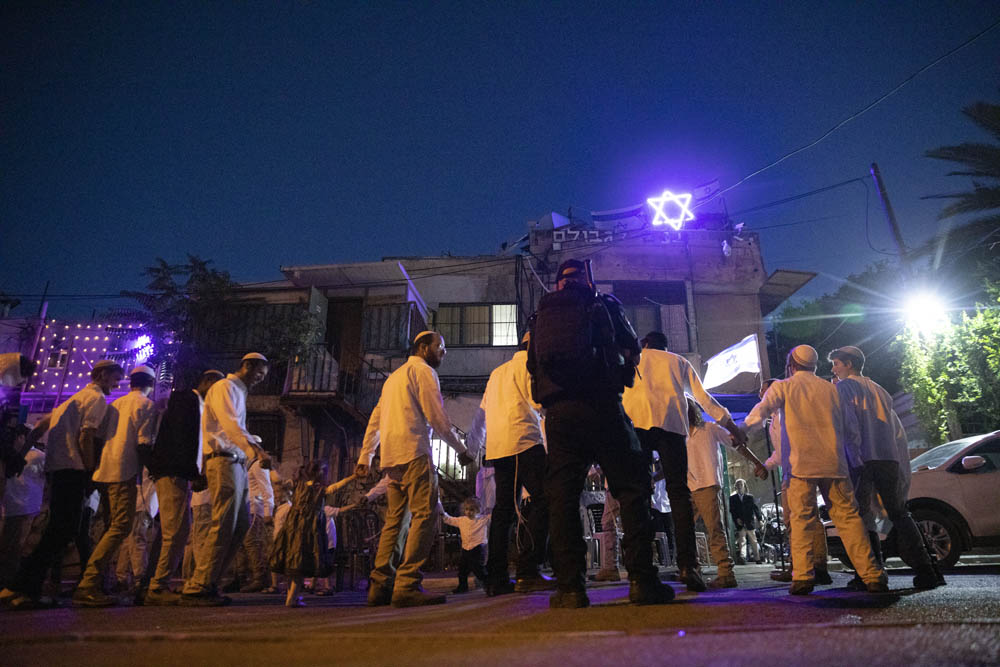 |
Israeli settlers celebrate the Sabbath under the protection of armed Israeli police officers in the East Jerusalem neighborhood of Sheikh Jarrah, May 7, 2021. (Oren Ziv)
On Saturday, the day before the arrest of Muna and Mohammed, Israeli forces attacked and arrested Al Jazeera reporter Givara Budeiri, despite the fact she was wearing a press vest and holding a microphone. Budeiri said the officers continued to beat her in the police vehicle. She was released later that night with a 15-day ban from Sheikh Jarrah. During her arrest, officers also assaulted an Al Jazeera camera operator and pushed him to the ground, damaging his camera.
On the day of Budeiri’s arrest, police officers were seen checking journalists’ press cards as they entered the neighborhood, while a small vigil by residents and activists was taking place. A Border Police officer was documented saying only journalists holding Israeli press cards issued by the Government Press Office (GPO) can enter the neighborhood, and that journalists without these cards will be removed.
The police have also declared a war on cultural events and Palestinian symbols in the neighborhood. For years, the police have confiscated and arrested activists who hold Palestinian flags — even though doing so is entirely legal. Last month, the police used a ladder to take down balloons with the colors of the Palestinian flag.
 |
A kite with a Palestinian flag flies above a Palestinian home that has been taken over by Israeli settlers in Sheikh Jarrah, East Jerusalem. (Oren Ziv)
In another incident two weeks ago, police came with municipality workers and erased graffiti with the names of the Palestinians under threat of eviction, which was painted by activists on the outer wall of El-Kurd family’s home. A day before that, far-right Jerusalem city council member Yonatan Yossef tried to erase another graffiti by himself, but was taken out of the area by the police.
“Why did they erase the drawing with the family’s names?” wondered Nabil El-Kurd. “What’s the problem with it? There is no law that allows this.”
On Saturday, police spent an hour trying to confiscate a kite with a drawing of the Palestinian flag on it. They had to give up since they did not have a warrant to enter the garden of the home from which the kite was flying.

